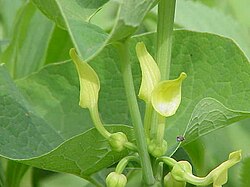Aristolochia
Aristolochia is a large plant genus with over 500 species of shrubs and herbs, many having medicinal properties. Collectively known as birthworts, pipevines or Dutchman's pipes, they are the namesake of the family (Aristolochiaceae). They are widespread and occur in the most diverse climates. Some species, like A. utriformis and A. westlandii, are threatened with extinction.
| Aristolochia | |
|---|---|

| |
| Aristolochia clematitis | |
| Scientific classification | |
| Kingdom: | |
| Division: | |
| (unranked): | |
| Order: | |
| Family: | |
| Subfamily: | |
| Genus: | Aristolochia |
| Species | |
|
Over 500, see text | |
Isotrema is usually included here, but might be a valid genus. If so, it contains those species with a three-lobed calyx.
Aristolochia Media
Calico flower (A. littoralis): habit
Aristolochic acid, the main toxin of pipevines
Aristolochia acuminata habitus drawing
Aristolochia arborea flowers
References
- American Cancer Society (ACS (2006): Known and Probable Carcinogens (Including Industrial Processes, Occupational Exposures, Infectious Agents, Chemicals, and Radiation). Version of 02/03/2006. Retrieved 2007-NOV-12.
- Depierreux, Michel; Van Damme, Baudewijn; Vanden Houte, Kaat; Vanherweghem, Jean Louis (August 1994). "Pathologic Aspects of a Newly Described Nephropathy Related to the Prolonged Use of Chinese Herbs". American Journal of Kidney Diseases. 24 (2): 172–180. doi:10.1016/s0272-6386(12)80178-8. PMID 8048421.
- Grollman, Arthur P.; Shibutani, Shinya; Moriya, Masaaki; Miller, Frederick; Wu, Lin; Moll, Ute; Suzuki, Naomi; Fernandes, Andrea; Rosenquist, Thomas; Medverec, Zvonimir; Jakovina, Krunoslav; Brdar, Branko; Slade, Neda; Turesky, Robert J.; Goodenough, Angela K.; Rieger, Robert; Vukelić, Mato; Jelaković, Bojan (17 July 2007). "Aristolochic acid and the etiology of endemic (Balkan) nephropathy". Proceedings of the National Academy of Sciences of the United States of America. 104 (29): 12129–12134. Bibcode:2007PNAS..10412129G. doi:10.1073/pnas.0701248104. PMC 1913550. PMID 17620607.
- Heinrich, Michael; Chan, Jennifer; Wanke, Stefan; Neinhuis, Christoph; Simmonds, Monique S.J. (August 2009). "Local uses of Aristolochia species and content of aristolochic acid 1 and 2 – a global assessment based on bibliographic sources". Journal of Ethnopharmacology. 125 (1): 108–144. doi:10.1016/j.jep.2009.05.028. PMID 19505558.
- Stiborová, M.; Frei, E.; Breuer, A.; Bieler, C.A.; Schmeiser, H.H. (July 1999). "Aristolactam I a metabolite of aristolochic acid I upon activation forms an adduct found in DNA of patients with Chinese herbs nephropathy". Experimental and Toxicologic Pathology. 51 (4–5): 421–427. doi:10.1016/S0940-2993(99)80033-5. PMID 10445409.
Other reading
- Mathew, Jessy Elizabeth; Kaitheri, Srinivasan Keloth; DinakaranVachala, Seekarajapuram; Jose, Magi (2011). "Anti-inflammatory, Antipruritic and Mast Cell Stabilizing Activity of Aristolochia Indica". Iranian Journal of Basic Medical Sciences. 14 (5): 422–427. PMC 3586839. PMID 23493617.
Other websites
| Wikimedia Commons has media related to Lua error in Module:Commons_link at line 62: attempt to index field 'wikibase' (a nil value).. |
| Wikispecies has information on: Aristolochia. |
- Pictures of Aristolochia chilensis and Aristolochia bridgesii









